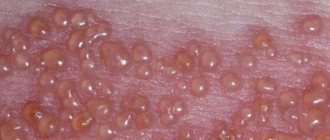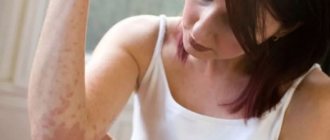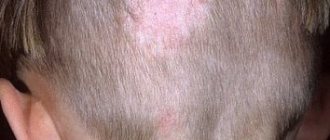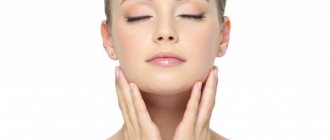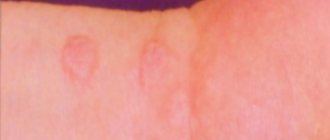How is shingles transmitted?
Herpes zoster (syn. - herpes zoster) is a secondary infection that develops only in people who have previously had chickenpox. Activation of the virus usually occurs against the background of a weakening of the cellular component of immunity and exposure to unfavorable factors, such as:
- Hypovitaminosis
- Taking hormonal medications
- Radiation or chemotherapy
- Blood diseases, diabetes, oncology
Women are more susceptible to relapses of herpes zoster, as well as carriers of the interleukin gene mutation and older people - for example, among adults aged 85 years, 50% of people have suffered at least one episode of the disease. And in patients with immunodeficiencies, in particular with HIV, the risk of reactivation of herpes type 3 increases 20 times compared to people with normal immune status.
Main symptoms of the disease
Herpes zoster mainly occurs on the body. At first it looks like pink spots. Soon they quickly become inflamed, turn red, and become covered with small blisters with transparent contents. Over time, the spots dry out and become crusty, and later they fall off.
The disease is characterized by severe attacks of pain, which can worsen at night.
Other signs of the disease:
- temperature rises to 39°C;
- painful rashes;
- headache;
- trembling and coldness in the body;
- runny nose (in children).
How to relieve pain from shingles
The main symptom of herpes zoster, which distinguishes it from other infectious diseases with skin manifestations, is pain, which can occur both before the rash appears and after it has healed. For pain relief, the doctor prescribes non-steroidal anti-inflammatory drugs.
A common complication of herpes zoster is postherpetic neuralgia, a severe pain syndrome that lasts at least 120 days. Pain can bother a person for several months and even years after recovery. Postherpetic neuralgia develops mainly in older people - for example, about 50% of cases are recorded in patients over 60 years of age.
Herpes zoster
Many of us breathe a sigh of relief after chickenpox (common childhood chickenpox). We think that the virus has been defeated and there is nothing to worry about. But this is not entirely true. The virus does not leave the body and under certain conditions can be reactivated. This insidious infection can cause complications in the form of postherpetic neuralgia, which manifests itself as excruciating pain along the peripheral nerves, and herpes zoster.
What is herpes zoster?
After chickenpox, the herpes virus enters the nerve ganglia (nodes) and can exist there for years without causing any symptoms. But with decreased immunity, stress, or in old age, the virus can suddenly become active. According to statistics, this can happen to every fifth of us.
Herpes zoster (shingles) usually begins with a fever and reddened area of the skin on the body, and there may be tingling in the area. Then blisters appear on the skin. The blisters are always located along the nerves, so the rash on the torso looks like a belt. Hence the name of the disease - herpes zoster. Pain may appear before or at the same time as the blisters. However, sometimes it does without skin manifestations.
Postherpetic neuralgia
Many people recover from herpes zoster without consequences. But sometimes the rash goes away, but the pain remains. Or the pain returns a month after recovery. This situation develops in 10–20% of cases and is a complication of herpetic infection.
Excruciating pain occurs at the site of the rash and is called postherpetic neuralgia or “belt of hellish roses.” The pain is burning, pulling, stabbing, quite pronounced, and often interferes with sleep. The slightest touch to the skin, even wearing clothing, can cause unbearable pain. If postherpetic neuralgia is not treated, it may go away on its own within a year after the disease, but more often the pain lasts for years and requires special medications.
At-risk groups
Herpes zoster, as well as its complication - postherpetic neuralgia - is most susceptible to older people. But even in young patients, widespread rashes, especially those that appear after the onset of pain, as well as high fever at the onset of the disease very often lead to postherpetic neuralgia. However, there is always an opportunity to reduce the likelihood of this complication occurring.
Which doctor should I contact?
For classic herpes zoster with skin rashes, a consultation with an ID-Clinic dermatologist is required. The doctor will conduct an initial diagnosis and, if necessary, give a referral to a neurologist or infectious disease specialist. To make a diagnosis, the patient will need to undergo an extensive examination.
Taking into account the results obtained, the doctor selects an individual treatment regimen using antiherpetic drugs, painkillers and other medications. With timely initiation of therapy, the prognosis is favorable.
Reasons for virus activation
The triggering factor for the proliferation of Varicella zoster and its release from the nerve ganglia is considered to be a decrease in the body’s immune defense. Physiological suppression of the immune system is observed in older people, and temporary disturbances in the functioning of the immune system occur with acute and chronic diseases, stress, poor low-calorie diet, mental and physical stress.
Patients at risk are:
● with congenital and acquired immunodeficiencies;
● taking immunosuppressive therapy;
● receiving courses of chemoradiotherapy;
● have undergone bone marrow transplantation or internal organ transplantation.
Rules for water procedures
- Take a shower rather than a bath to avoid spreading the infection to other areas of the skin.
- Wash once every two days to reduce irritation to areas of inflammation.
- The water should not be hot, and in no case should you create a “steam room” (by the way, visiting a sauna is also contraindicated).
- Do not rub yourself with a washcloth, do not use a scrub, because multiple damage to the bubbles can lead to bacterial complications.
- Detergents are needed with a neutral pH of 5.5 - they are gentle on the epidermis.
Principles of treatment
Herpes can and should be treated. Currently, medicine has a whole arsenal of drugs that, in most cases, make it possible to obtain a lasting clinical effect in those who suffer from recurrent herpes and to successfully control periods of activation of the disease in asymptomatic forms. It is impossible to achieve complete removal of the virus from the body using currently existing treatment methods; it is possible to maintain the body in a state where the virus does not have a chance to activate. Currently, there are two main directions of treatment for herpes simplex:
- The use of antiviral drugs, the main place among which is occupied by acyclovir-containing (ACV) drugs. In case of exacerbation of herpes, the first aid remedy is medications containing acyclovir: ZOVIRAX, VAPTREX, ACICLOVIR-ACRI, VIROLEX. They are available in the form of tablets and creams. The same drugs are used locally in the form of cream and ointment. Taking these medications should begin in the first hours of an exacerbation.
- A complex treatment method that includes immunotherapy in combination with antiviral therapy. As a rule, the disease occurs against the background of suppressed immune reactions, so immunotherapy plays an important role in the treatment of herpes. If relapses of the disease are seasonal (autumn, spring) and they are accompanied by symptoms of ARVI, then to antiviral treatment with drugs containing acyclovir, it is advisable to add a course of drugs that stimulate the synthesis of interferon (a substance produced by the body and providing an antiviral effect): herbal immunostimulants (for example, IMMUNAL) and synthetic drugs such as ARBIDOL, AMEXIN, VIFERON, KIPFERON. Moreover, they can be used for preventive purposes about a month before the onset of autumn slush and spring hypovitaminosis). If relapses of herpes (at any location) occur more than 3-4 times a YEAR, this is a reason to consult a doctor. This means that the body's defenses (immunity) cannot cope with the infection. In such cases, after studying the immune status, the patient is prescribed complex treatment, including antiviral and immune drugs. In patients with recurrent herpes, the drugs TACTIVIN, TIMALIN, THIMOGEN, MYELOPID, etc. are successfully used (treatment must be carried out after an immunological study).
Atypical forms of the disease
In some cases, the course of herpes zoster differs from the classical pattern, which makes timely diagnosis difficult. There are several forms of Herpes zoster:
1. Abortive. It has minimal clinical manifestations: malaise, weakness, redness and swelling of the skin without rashes. The duration of the illness does not exceed several days.
2. Bullous. Skin symptoms include flaccid blisters the size of a pea or larger, which are filled with clear fluid. This type of herpes zoster is accompanied by severe intoxication.
3. Hemorrhagic. Develops in patients with a suppressed immune system. In this case, the lesion affects the deep layers of the skin: the blisters are filled with bloody contents, and dark brown crusts appear.
4. Gangrenous. Another variant of Herpes zoster, typical for elderly and weakened patients. Skin inflammations do not heal for a long time, turning into ulcers that leave behind rough scars.
5. Generalized. It is characterized by the spread of a herpetic rash over a large area of skin beyond the zone of innervation of one nerve. This form is observed in immunocompromised patients.
Many-sided, insidious
The properties of HSV are such that almost all human organs can be involved in the infectious process, which allows us to speak of herpes as a “herpetic disease” with a predominant lesion of one or another organ system. For example, the eyes, ENT organs (pharynx, larynx, ear), lungs, genitals, gastrointestinal tract, central nervous system (meninges, nerves), skin and mucous membranes (face, lips, oral mucosa) may be affected. ) etc.
The frequency and intensity of exacerbations of recurrent herpes depend on the activity (aggressiveness) of the pathogen, as well as on the resistance of the human body.
Exacerbations of herpes infection are not always accompanied by the appearance of typical rashes in the form of blisters. The insidiousness of herpes lies in the fact that very often a person, without knowing it, becomes a source of infection for others. This applies to both facial herpes and genital herpes, which often manifests itself only in severe pain (in the facial area or in the pelvis, respectively).
When herpes worsens (when rashes appear), the patient becomes acutely contagious. Kissing a loved one or relative during an exacerbation can lead to the appearance of herpes in a previously healthy person. In addition, under unfavorable circumstances and failure to comply with personal hygiene rules, conditions for self-infection may arise. Thus, the virus can be carried from a lesion on the lips by hands into the eyes and genitals. In the presence of microtraumas in these areas, new foci of the disease arise: ocular herpes or genital herpes.
Genital herpes
Genital herpes (GG) is one of the most common infections of the genitourinary system, most often caused by HSV-11. Infection occurs through close physical contact with a patient or virus carrier during genital, oral-genital, genitorectal and oral-anal contact. There are primary and recurrent genital herpes.
With primary genital herpes, the incubation period (the period from infection to the appearance of the first symptoms of infection) is 1-10 days and differs from subsequent relapses in a more severe and prolonged course. Clinical symptoms of primary HH develop in only 10% of infected people and are characterized by the appearance on the mucous membranes of the genital organs and adjacent areas of the skin of single erosions or grouped small blisters filled with liquid, with redness around them. After 2-4 days, the contents of the blisters become cloudy, and they burst, forming weeping ulcers, which then heal. Subjectively, patients are bothered by itching, burning, and pain in the affected area. Some patients experience an increase in body temperature up to 38°C and a painful enlargement of the inguinal lymph nodes. If the course of the disease is favorable, after 5-7 days the crusts disappear and a stain remains in their place. Even without treatment, symptoms usually go away on their own within 2-3 weeks. Subsequently, for many, the disease recurs, and the time until the next relapse can range from several weeks to several years.
Recurrent genital herpes is characterized by a chronic course, disruption of the patient’s sexual and reproductive functions. The disease is difficult to treat. Herpetic rashes can appear on the labia majora and minora, vaginal mucosa, cervix, and perineum. The duration of the rash does not exceed 3-5 days. In some cases, during a relapse, visible rashes are not detected at all, but swelling, itching, and a feeling of discomfort in the genital area appear. The disease may be accompanied by fever, general weakness and malaise, enlargement and tenderness of the inguinal lymph nodes (usually on one side).
A feature of genital herpes is multifocality: the pathological process often involves the lower part of the urethra (urethra, bladder, which is manifested by pain and pain at the beginning of urination, frequent urination) and the mucous membrane of the rectum (recurrent cracks occur), as well as the upper parts of the genital tract (uterus, ovaries and fallopian tubes). In the latter case, the appearance of mucous discharge from the vagina, periodic pain in the pelvis, in the area of the projection of the uterus, ovaries (symptoms of irritation of the pelvic nerve plexus) are possible. Moreover, these symptoms are often associated with a certain phase of the menstrual cycle (with ovulation or the perimenstrual period). It is not uncommon that the viral nature of the disease is not recognized, and patients are treated for a long time by gynecologists with antibacterial and antifungal drugs to no avail.
Towels, bed, linen
When the pathogen is activated, planned surgical interventions are contraindicated, so you can find out the prices for mole removal, but you will have to wait a bit with the manipulation itself. Firstly, a person in this phase experiences a lot of unpleasant sensations: burning, itching, hypersensitivity of the skin - there is no need to increase the discomfort. Secondly, at the stage of the appearance of vesicles with serous fluid, the patient is contagious, so it is better to limit contact with him.
To avoid infecting family members during the period of rashes, the patient should avoid close hugs and do not allow other people to use their towels for their hands, face and body. Bed linen should be free of starch and made of 100% cotton: this absorbs liquid from burst bubbles well. For the same reason, cotton underwear is also preferable.
Methods of treating the disease
Herpes zoster on the face and other areas is treated on an outpatient basis. Inpatient treatment is required only for the generalized form, as well as complications.
The peculiarity of therapy is its complexity - taking antiviral and immunostimulating medications.
Therapy involves relieving intoxication and pain, preventing the progression of infection. For secondary bacterial infections, antibiotics are used. To relieve rashes, use brilliant green and 5% dermatol ointment locally. If the process is sluggish, the doctor may prescribe metacil ointment or solcoseryl.
For herpes zoster on the neck or other areas, physiotherapeutic procedures are also sometimes prescribed.
Diet is important for the effectiveness of therapy. Exclude from the diet:
- fat meat;
- animal fats;
- spicy foods.
